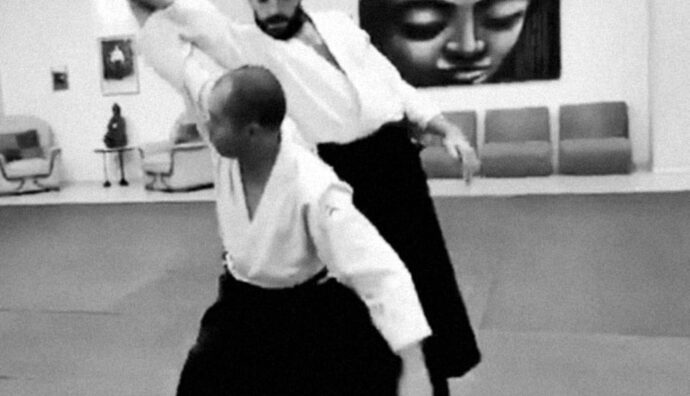Everyone has their own tastes, even if sometimes incomprehensible.
There are those who put pineapple on pizza, those who state that trap music is beautiful, those who dress socks when wearing sandals…
Nevertheless, up to now, we have not yet found on our path Aikido practitioners madly in love with koshinage. Why? Is it because it is a technique that sucks? Or because almost everyone suck in practicing it?
In Aikido we can group the technical program into three large families:
immobilization techniques (katame waza 固技)
techniques performed with weapons (buki waza 武器技)
throwing techniques (nage waza 投げ技)
There are, especially in the application field, many further ramifications, many of which for obvious reasons are not part of the technical program required for the tests. Among these, it is worth mentioning the breaking techniques (kansetsu 関節 waza), the strangulation techniques (shime 絞め waza), the “sacrifice” techniques (sutemi 捨て身 waza), and the myriad of applications (oyo 応用 waza). All specialties that have their roots in ancient jujutsu.
If we look at the teaching of Judo, we see that there is a large number of techniques grouped under the label “koshi waza”.
In fact, the use of the pelvis and hips (koshi 腰), is the heart of every movement and it is natural that it is widely trained in all martial disciplines.
However, in Aikido, which is contemporary with Judo, we only have one term: koshinage.
Seasoned in at least thirty sauces depending on the initial attack but it is always the same dish.
Three questions therefore arise:
Why is there still a trace of a koshi waza in Aikido?
Since the directly interested parties can no longer answer, we can assume a few hypotheses. Let’s immediately discard a hypothesis of technical completeness with respect to potential attacks, because, for the same completeness, we should study for instance all the didactic of kicks that exists in other disciplines which does not exist in Aikido.
If as a reference the statement that supports the coincidence between bare-handed techniques and those with weapons, we can see that some uke loadings on nage’s sides follow geometries that can be traced back to shihonage and kaitennage soto mawari, which ultimately derive from sword techniques. In other forms the hands that grab uke to lift him/her take the same inclination as when the jo goes into hasso 八相 position and/or performs a gyakute uchi 逆半手打ち. It is a somewhat forced analysis, because in some cases the similarity is clearly visible, in others one must work one’s imagination. From this perspective, koshinage would be, among the koshi waza, the only one to guarantee a minimum coherence with the teaching structure of the remaining techniques.
All the other statements, while in themselves having some basis in reason, do not fully justify the existence and survival of koshinage in the technical program. For example: if the goal is to develop proprioceptive and kinesthetic sensitivity in the back, it is not necessary to load a person like a bunch of potatoes to do so, because there are other methods, much less burdensome for the spine and joints.
Is koshinage an Aikido technique?
It looks like a stupid question, yet… A beginner is taught not to pull his partner towards him. In koshinage, no matter how much (usually) uke’s arm is extended and no matter how much the latter, losing balance, becomes “lighter”, there is always a moment in the technique in which nage hoists uke’s mass, somehow pulling him towards him. This is clearly seen when the technique is performed starting from static holds or from a slow dynamic condition. Sometimes, but it happens very seldom, when the dynamic action is fast and the partner is good/lucky in entering with the proper angle and at the right time, koshinage becomes an Aikido technique again. The hips become a fulcrum placed in the movement of a body, a wedge that unbalances a body in a fraction of a second, modifying its trajectory.
Which teaching?
Koshinage is also a challenge for teachers. In the basic study it is generally proposed right from the beginning as a pair practice. Anyone who has been through it remembers loading done on the back (and not on the hips), straight legs, wobbly knees and a consequent melting of the couple on the tatami. It would seem that one cannot help but have this experience. Recently, however, at the Dojo we have started preparatory exercises using the jo as a support to extend the arm and maintain the entry angle. This could be a methodology that would save several muscular and tendon discomforts, while speeding up the learning of the form with a geometry not tainted by the sum of insecurities that are activated at each exchange.
In conclusion…
Koshinage is not taught and practiced because it is just in the technical program. If this were the only motivation, it would be unacceptable.
Certainly koshinage is a good example of the Japanese teaching style. A vertical, massive wall placed there, amid in the growth path, without an apparent reason.
A sieve that filters very well and separates what is the will to continue from the desire to think that everything and always is free. A tool, in the hands of a teacher and practitioner, useful to identify and put into circulation those resources that we think we do not have and that actually we do have. Every damned koshinage teaches us that we can still become.

